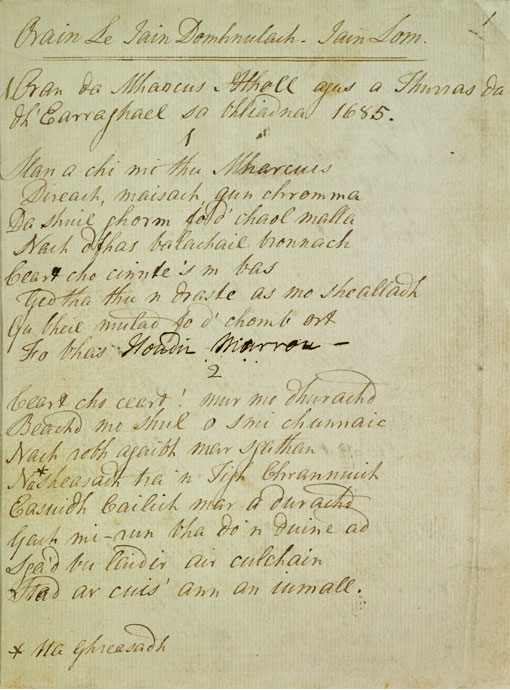Murtadh na Ceapaich (The Keppoch Murder)
More commonly referred to now as 'Murt [or Mort] na Ceapaich'
This poem commemorates the murders of the young chief of Keppoch, Alasdair MacDhòmhnaill Ghlais and his younger brother Raghnall Òg in 1663. The murders were committed by about 30 assailants going by the number of wounds said to have been inflicted on the brothers. Subsequent events spread Iain Lom's fame far and wide due to the part he played in avenging the deaths.
Much of the following story is based on oral tradition rather documented history.
The story behind the crime involved a complex clan struggle for power, property and land. It centered around a feud between two branches of the MacDonalds of Keppoch, 'Sliochd an Taighe' and 'Taigh na Ceapaich', the MacDonalds of Keppoch House.
Alasdair MacDhòmhnaill Ghlais and his younger brother Raghnall Òg had both been sent to Rome to be educated but in their absence their father died. This presented an opportunity for their uncle Alasdair Buidhe known as 'the Tutor' to attempt to consolidate power for himself. However, Five years later, the brothers returned to Keppoch to take up the leadership of the clan. Dissatisfied at being forced to give way to his nephew, 'the Tutor' was by all accounts a scheming and ambitious man who encouraged discontent against the young Keppoch chief.
Events finally came to a head when Alasdair Ruadh mac Dhùghaill of Inverlair, who had held a long-standing grudge against the Keppoch family, set out one night with his six sons and other supporters to murder the brothers. He and the others entered the house and finding the young chief defenceless in his bed, plunged their dirks into his body, killing him on the spot.
Ranald, the younger brother wasn't in the house but when he heard the commotion he quickly went to his brother's rescue. On entering the house, he was seized right away and overpowered. He cried out to his uncle who was there for help but instead of trying to protect him his uncle 'the Tutor' plunged the first dagger into his chest.
Following the murders, Iain Lom had the bodies carefully laid out and honourably buried. He exhorted his fellow clansmen, the MacDonalds of Keppoch, to avenge the death of their young chief but there was no appetite for this among the clan. Instead, he took his plea to their powerful neighbour, Aeneas MacDonnell, Chief of Glengarry but Glenglarry likewise did not want to interfere.
Nevertheless, Iain Lom was utterly convinced that his cause was just and honourable. Through his unwavering campaign for justice and utilising his considerable poetic skills, he took his entreaties to Sir James MacDonald of Sleat. This resulted in a commission issued by the Privy Council on the 29th of July, 1665, listing the following persons to be put to fire and sword:
Allan MacDonald, son of the Tutor of Keppoch;
Donald MacDonald, brother of Allan
Alexander MacDougall in Inverlair
John Roy MacDougall, brother of Alexander
Donald Orie McCoull
Dugall McCoull in Tallie
Patrick Dunbar
A messenger was then sent to Sir James' brother in North Uist, Archibald MacDonald known as 'An Ciaran Mabach', with instructions to bring a number of chosen men to the mainland where they would meet Iain Lom.
In September 1665 under the leadership of An Ciaran Mabach, the Uist men along with Iain Lom took their revenge and murdered the men who had been responsible for the deaths of the young chief and his brother. This event has long been seen as a clear example of the power poets could wield in earlier Gaelic society.
On their way to Invergarry to present the heads to MacDonnell of Glengarry, Iain Lom washed the heads in a well by Loch Oich that has since been called 'Tobar nan Ceann' ,'The Well of the Heads'. The last chief of Glengarry erected a monument here in 1812 with a Gaelic inscription that can still be seen today.
From Invergarry, Iain Lom and the other men went north to Inverness as instructed by Glengarry. On the way an incident occurred that showed off the Keppoch bard's talent for biting satire.
On arrival at the Inn of Cluanmore in Glenurquhart, the man who carried the heads in a creel basket threw it carelessly down and so caused the severed heads to rattle around. Iain Lom exclaimed on hearing this: “Ud! Ud! Nach còrd sibh! 's gur cloinn chàirdean sibh!” - What! What! Won't you agree, won't you agree and you being so near a kin!”
Find out more about Iain Lom and other Gaelic bards by searching for them in the National Library of Scotland catalogue.
